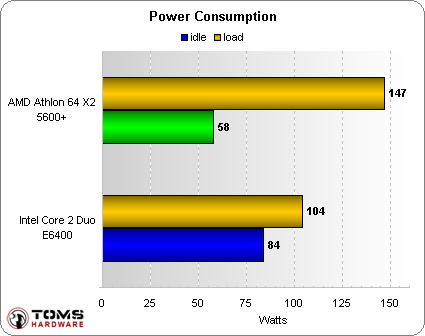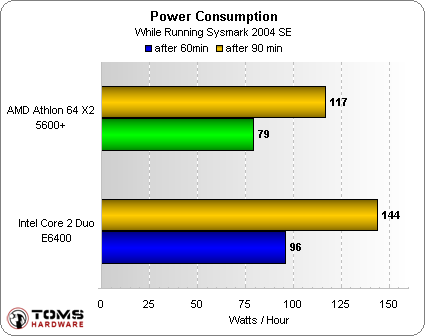Current Mainstream CPU Lineups
Power Consumption Results
Power Draw
Energy Requirements Over 60/90 Minutes
We added a new power consumption discipline to our test bed, which consists of looping SYSmark 2004 SE. We did this to determine the actual amount of energy that the test systems with Athlon 64 X2 and Core 2 Duo processors require over a certain period of time, in Wh.
The results are impressive: although AMD's Athlon 64 X2 5600+ is a 90 nm part rated at 89 W, and the Core 2 Duo E6400 is a modern 65 nm product rated at 65 W, the AMD system required clearly less energy over a period of 60 or 90 minutes. SYSmark includes office productivity and content creation applications, which reflects the heavy use of a computer running these applications.
Conclusion
We did not include Intel's high-end Core 2 Duo and Core 2 Extreme processors in this project, as these are far superior to AMD's current portfolio - and far more expensive. (If you are looking for performance benchmarks on all processors, please have a look at our Interactive CPU Charts.) Instead, we focused on processors that we believe deliver the best price/performance ratio: the Core 2 Duo E6400 at 2.13 GHz, and the Athlon 64 X2 5600+ at 2.8 GHz. You can get any one of these for less than $200. This is still a lot of money, but these processors will last for a while, and you might be able to replace them with future quad core CPUs, although this depends on the mercy of AMD and Intel.
AMD's Athlon 64 X2 processors 5600+ and 6000+ did well in the synthetic benchmarks and in 3DMark. They also deliver good performance to compress files with WinRAR, process pictures in Adobe Photoshop CS2 or create large PDF documents with Acrobat 7, thanks to their integrated memory controller. They don't have a chance against the Core 2 Duo, however, if you are looking to encode or transcode digital audio or video. If you are willing to spend more than $200 on the processor, Core 2 Duo still is the only reasonable choice.
In other words: AMD still provides a great value, but mostly in the mainstream. This conclusion might be even more interesting for people that have to purchase hundreds or even thousands of systems: clearly, the AMD test machine required less energy, as its idle power draw is considerably lower (58 W versus Intel's 84 W). Most office or multimedia PCs typically spend most of their time running idle or almost idle, which explains AMD's dominance, even with an aged 90 nm processor.
Join our discussion on this topic
Get Tom's Hardware's best news and in-depth reviews, straight to your inbox.

Patrick Schmid was the editor-in-chief for Tom's Hardware from 2005 to 2006. He wrote numerous articles on a wide range of hardware topics, including storage, CPUs, and system builds.

